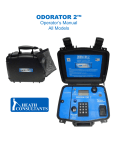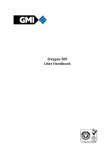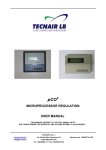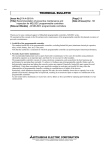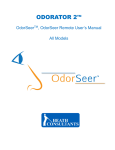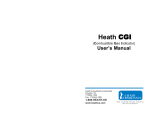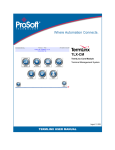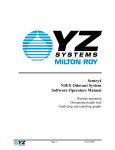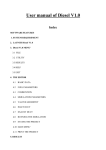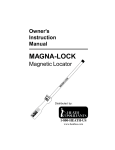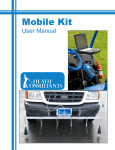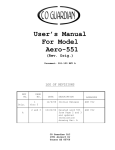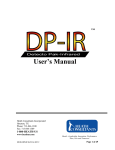Download Odorator PDF - measurementcontrols.com
Transcript
ODORATOR® User’s Manual PROPRIETARY NOTICE The contents of this instruction manual are proprietary to the Manufacturing Division of Heath Consultants Incorporated. Reproduction of this manual, in whole or in part, is prohibited without the express written consent of Heath Consultants Incorporated. Heath Consultants Manufacturing Division operates under a continual product improvement program and reserves the right to make improvements and/or changes without prior notification. This manual supersedes all previous manuals for this instrument. COPYRIGHT 2002, HEATH CONSULTANTS INCORPORATED HPN. MANUAL: 0715630 Rev. C HPN. ODORATOR Complete Unit: 0705637 ODORATOR ® User ’s Manual Heath Consultants Incorporated Houston, TX 713/844-1300 Fax: 713/844-1309 1-800-HEATH-US www.heathus.com Heath....Leadership, Innovation, Performance Then, Now and Tomorrow INTRODUCTION Natural Gas (Methane) to be analyzed enters the ODORATOR through the barbed fitting at the gas supply intake port. Internally, the gas passes through an internal five micron filter to the input of a low pressure regulator. It then passes from the output of the low pressure regulator to the flow valve. This valve, located on the front panel of the ODORATOR, is operated by the user. After passing through the valve (when opened) the gas enters the mass flow sensor. This is the heart of the ODORATOR. The mass flow sensor responds to gas flow within the range of the flow valve. The signal from the mass flow sensor is then processed, converted to a digital signal, and fed to a liquid crystal display (LCD). The gas from the mass flow sensor then passes to the mixing chamber assembly where it is combined with air drawn in by a blower motor and impeller. The operator then samples the gas/air mixture at the exhaust sniffing port. When odorant is detected, the operator presses the READ switch to display percent natural gas. The electronics and the speed of the blower motor are calibrated so that the concentration of the gas/air sample at the exhaust port agrees with the LCD at the 20% Lower Explosive Level (L.E.L.) which is 1% gas. All other values must be corrected using the chart. The correction chart is included to linearize the instrument in its range. To use the chart, record both the ODORATOR reading and the corrected reading. For ODORATOR readings not specified in the chart, linearly interpolate between the next highest and lowest points on the chart. Do not extrapolate beyond the readings on the chart. Depending on how much the valve is opened, the concentration of gas/air at the blower exhaust port will be anywhere from zero to approximately 2.50%. The LCD i can only read to 1.99%. Concentrations above 1.99% will be indicated by the LCD having its last two digits blanked out as “1.--”. When the ODORATOR is turned on, the operator might momentarily notice the letter “L” on the LCD when the READ switch is depressed. If the “L” fails to disappear, it may indicated insufficient blower speed, such as would occur if the motor and impeller weren’t turning at all or too slowly. The “L” indicates low blower speed. When it is time to replace the batteries, “LO BATT” will be indicated in the upper left corner of the LCD when the READ switch is depressed. ii WARNINGS AND CAUTION IT IS ESSENTIAL THAT USERS OF THIS INSTRUMENT READ, UNDERSTAND, AND FOLLOW THE INSTRUCTIONS FOR OPERATION AND MAINTENANCE AND THE PRECAUTIONS CONTAINED IN THIS MANUAL TO INSURE THE INSTRUMENT IS USED IN A PROPER AND SAFE MANNER. DURING OPERATION, KEEP THE ODORATOR AWAY FROM OPEN FLAMES. INLET SUPPLY PRESSURE SHOULD NOT EXCEED FOUR P.S.I.G. INLET PRESSURES IN EXCESS OF FOUR P.S.IG. WOULD RUPTURE THE LOW PRESSURE REGULATOR DIAPHRAGM WHICH WOULD VENT THE GAS OUT OF THE INSTRUMENT AND CAUSE AN INSTRUMENT FAILURE. WHEN CALIBRATING THE ODORATOR, YOU WILL BE WORKING WITH FLAMMABLE GAS (NORMALLY METHANE GAS) WHICH IS POTENTIALLY DANGEROUS IF NOT HANDLED PROPERLY. METHANE GAS FROM A LECTURE BOTTLE MAY BE ODORLESS AND IS FLAMMABLE IN CONCENTRATIONS OF APPROXIMATELY 5.0 TO 15.0 PERCENT BY VOLUME IN AIR. WHEN YOU ARE NOT CALIBRATING OR OPERATING THE ODORATOR, CLOSE ALL VALVES AND TURN THE ODORATOR OFF. ANY TIME GAS IS BEING PASSED THROUGH THE ODORATOR THE POWER SWITCH MUST BE TURNED ON. THIS WILL DILUTE THE GAS AT THE BLOWER EXHAUST AND PREVENT POCKETS OF GAS ACCUMULATING. 100% L.E.L. IS APPROXIMATELY EQUAL TO 5% METHANE GAS BY VOLUME IN AIR. AS LONG AS THE C.G.I. READS BELOW THIS YOU SHOULD NOT HAVE ANY PROBLEM WITH A FLAMMABLE MIXTURE BUILDING UP. ANY SUSPICION OF A GAS LEAK BY UNEXPLAINED SOUND OR OPERATION OF THE ODORATOR IS REASON TO IMMEDIATELY SHUT OFF THE GAS SUPPLY VALVES AND ODORATOR POWER SWITCH, THEN SEEK THE CAUSE. iii DURING CALIBRATION, KEEP THE ODORATOR AWAY FROM OPEN FLAMES, INLET PRESSURE SHOULD NEVER EXCEED 4 P.S.I.G., AND DO NOT OBSTRUCT OR BLOCK THE BLOWER INTAKE OR EXHAUST. CAUTION: BECAUSE OF INHERENT LIMITATIONS, LIQUID CRYSTAL DISPLAYS SHOULD NOT BE SUBJECTED TO EXTREMES OF TEMPERATURE OR HUMIDITY. IF THE UNIT IS EXPOSED TO A TEMPERATURE BELOW FREEZING OR ABOVE +49âC (+120âF), THE LIQUID CRYSTAL DISPLAY MAY TEMPORARILY CEASE TO FUNCTION PROPERLY, AND IN SOME CASES PERMANENT DAMAGE MAY RESULT. IT IS THEREFORE RECOMMENDED THAT THE INSTRUMENT NOT BE SUBJECTED TO EXTREME CONDITIONS SUCHASACLOSED VEHICLE IN DIRECT SUNLIGHT OR CONTINUOUS SUB-FREEZING TEMPERATURES. USEATALTITUDE: THE ODORATOR MUST BE USED WITHIN 1000 FEET OF ITS CALIBRATION ALTITUDE FOR ACCURACY. READING CORRECTION CHARTS, AS FOUND IN APPENDIX D, MUST BE USED FOR ALTITUDES GREATER THAN 1000 FEET. iv TABLE OF CONTENTS INTRODUCTION ....................................................... WARNINGS AND CAUTION ..................................... TABLE OF CONTENTS ............................................. CHAPTER I OPERATION Instructions for Operation .......................................... A. Procedures ..................................................... Periodic Test .............................................................. Front Panel Figure 1 ............................................................... CHAPTER II CALIBRATION Field Calibration Procedure ....................................... A. Required Equipment ...................................... B. Procedures .................................................... Potentiometers On The PCB ...................................... A. Speed Potentiometer ...................................... B. Span Potentiometer ........................................ C. (Coarse) Zero Potentiometer ......................... D. Flow Potentiometer ........................................ Potentiometer Location Figure 2 ............................................................... Field Calibration System Figure 3 ............................................................... v CHAPTER III MAINTENANCE INFORMATION Troubleshooting Chart ............................................... Parts List ................................................................... Appendix A Alternate Test Method ........................................ Appendix B Field Calibration & Periodic Test Records .......... Appendix C ODORATOR Natural Gas Calibration Chart ....... Appendix D Use at Altitude.................................................... CHAPTER IV SERVICE INFORMATION Warranties and Warranty Repair ............................... Customer Service, Manufacturing and Instrument Repair Locations........................................................ Notes ......................................................................... vi OPERATION Chapter I OPERATION: This Chapter discusses, in detail, the proper steps to safely operate the ODORATOR. Also included are procedures for periodic testing, and identification of the ODORATOR’s controls. Operation of the ODORATOR WARNING DURING OPERATION, KEEP THE ODORATOR AWAY FROM OPEN FLAME. INLET SUPPLY SHOULD NOT EXCEED 4 P.S.I.G. **NOTE** Connect the ODORATOR to the gas supply with a non-absorbing, odor-free hose such as high grade urethane, PVC, or Tygon. **NOTE** Operators of the ODORATOR should be selected with due consideration to smoking habits, colds, and other conditions of health, since these factors affect the sense of smell. It is desirable to select operators with an average sense of smell in order to obtain reasonably consistent results from the use of this instrument. **NOTE** See Figure 1 on page 4 for reference to the following steps. A. Procedures **NOTE** See Appendix A for Alternate Test Method. 1. Connect the sample hose to the gas supply outlet valve and to the ODORATOR inlet port.(1) 1 OPERATION 2. Gently, turn the flow valve(6) clockwise until closed. 3. Turn the power switch(2) to “on” position. 4. Open the gas supply outlet valve. 5. For new instruments turn the flow valve(6) counter-clockwise fully to open the valve. This will condition the ODORATOR system. Wait for about 30 seconds or until you smell an odor of gas at the blower exhaust, which ever occurs first, then immediately turn the flow valve clockwise to fully close the valve. 6. Push the read switch(5) and while holding it down adjust the zero knob(7) until the LCD reads “.00”. Release the read switch. 7. Sniff the un-odorized air stream at the exhaust port. 8. Slowly open the flow valve counter-clockwise while sniffing with your nose directly over the blower exhaust port approximately 3/4”. Your upper lip should lightly touch the front edge of the blower exhaust port. 9. When a change in odor, or first faint smell of gas is detected, stop turning the flow valve and push the read switch. Make a note of the percent gas reading shown on the LCD(4). This is the threshold limit value or threshold value. Considerable variation will exist between individuals in detecting this threshold value. The correction chart is included to linearize the instrument in its range. To use the chart, take the ODORATOR reading and look up the corrected reading. For ODORATOR readings not specified on the chart, linearly interpolate between the next highest and lowest points on the chart. Do not extrapolate beyond the readings on the chart. **NOTE** The operator should frequently pause when sniffing for odorant, moving the nose away 2 OPERATION from the instrument, breath fresh air, then continue the test. This precaution is necessary because the sense of smell fatigues rapidly during this type of test. 10. Close the gas supply valve. 11. Disconnect the sample hose from the gas supply outlet. 12. Fully open the flow adjustment valve counterclockwise and leave the ODORATOR on for approximately one minute after the test to purge the mixing chamber. 13. Turn the ODORATOR off. Periodic Test A. Every thirty days the ODORATOR should be operated with the power switch on and while not hooked up to a gas supply. B. Sniff the exhaust port (Inhale normally through your nose). C. If no odor is detected, turn the ODORATOR off. The ODORATOR has not absorbed the odorant. D. If an odor is detected, turn the ODORATOR off and send it to the nearest Heath Repair Center (Regional Office) listed on page 27. The odor is an indication that the ODORATOR has absorbed the odorant and must have its internal tubing replaced and gas flow components purged. 3 OPERATION ODORATOR Top Panel 1 2 3 4 5 7 6 8 Figure 1 1. Gas Inlet 5. Read Switch 2. Power Switch 6. Flow Adjust Valve 3. Power Indicator 7. Fine Zero 4. LCD 8. Blower Exhaust 4 OPERATION Chapter II CALIBRATION: Field Calibration Procedure A. Required Equipment 1. Field Calibration Test Kit Includes items a - i listed below: (HPN 0727675) a. Lecture Bottle 99.9% methane (CH4), balance zero air, refillable. (HPN 0123519) b. Regulator, high pressure Lecture bottle type, used to lower lecture bottle pressure to 10 p.s.i.g., ! 1 p.s.i.g. (HPN 0111004) c. Regulator, low pressure Low pressure type, used to lower lecture bottle pressure to 10 p.s.i.g. outlet pressure to seven inches of water column. (HPN 0716725) d. Combustible Gas Indicator (C.G.I.) Dual scale type 100% L.E.L. scale plus a 10% L.E.L. scale. GMI GASURVEYOR #3 calibrated for methane is included. (HPN 22012220) e. Adapter Blower exhaust port on the ODORATOR. This is the outlet sample point for the above C.G.I. (HPN 0716773) f. Tubing Blower exhaust adapter to the C.G.I. inlet (2ft long) and 5 CALIBRATION for the lecture bottle regulator outlet to low pressure regulator inlet (also 2ft long). (HPN 8301846 by the ft) g. Fitting, (1/8” MPT x 3/16” tubing barb) Lecture bottle regulator outlet (1/8” FPT) to tubing (3/16” barb) (HPN 8300323) h. Accessories Cylinder, disposable, 1.0% methane, balance zero air. (HPN 0716831) Adapter valve (HPN 09140000200) and test bag (HPN 09140009607) are needed to utilize disposable cylinders. These items are required to verify or adjust the calibration of the GMI GASURVEYOR #3. i. Optional Equipment GMI filter (Box of 10), for input filtration of the GMI GASURVEYOR #3. (HPN 22210077) WARNING ANY SUSPICION OF A GAS LEAK BY UNEXPLAINED SOUND OR OPERATION OF THE ODORATOR IS REASON TO IMMEDIATELY SHUT OFF THE GAS SUPPLY VALVES AND ODORATOR POWER SWITCH, THEN SEEK THE CAUSE. DURING CALIBRATION, KEEP THE ODORATOR AWAY FROM OPEN FLAMES, INLET PRESSURE SHOULD NEVER EXCEED 4 P.S.I.G., AND DO NOT OBSTRUCT OR BLOCK THE BLOWER INTAKE OR EXHAUST. USE AT ALTITUDE. SEE APPENDIX D. 6 CALIBRATION B. Procedure 1. Calibrate or verify the accuracy of the C.G.I. with 1% (20% L.E.L.) methane balance air mixture on the 100% L.E.L. scale. **NOTE** Set up the field calibration system using Figure 3 on page 10 as your guide, with all valves and power turned “OFF”. See Figure 1 on page 4 for the location of the top panel controls. 2. Turn the C.G.I. on and adjust the instrument to zero on the 100% L.E.L. scale. Turn the ODORATOR power switch to the “ON” position. Push the “ READ” switch and hold it down. Note that the low air indicator “L” on the LCD may be on. 3. Open the valve on the 99% methane gas lecture bottle. Open the valve at the outlet of the low pressure regulator. Observe the ODORATOR LCD. The reading should settle and not change (if it doesn’t, go to Step 12). Release the “READ” switch. 4. Open the ODORATOR flow valve a few turns counterclockwise. 5. If needed, adjust the low pressure regulator to read seven inches of water column. Also, if needed, adjust the lecture bottle regulator to read ten p.s.i.g. on its output gauge. 6. Close the ODORATOR flow valve by turning it clockwise until it stops. DO NOT FORCE IT. 7. Push the ODORATOR “READ” switch and hold it down. The low air indicator “L” on the LCD should not be displayed (if it is go to Step 12). 7 CALIBRATION 8. Adjust the ODORATOR zero knob until the LCD reads “.00”. Release the “READ” switch. 9. Open the ODORATOR flow valve 10 turns counter-clockwise and adjust the speed potentiometer(see figure 2 on page 9) until a reading of 20% L.E.L is indicated on the C.G.I. 10. Push the ODORATOR “READ” switch and hold it down. The LCD should read “1.00”. If it does not, adjust the Span potentiometer until the LCD reads “1.00”. The Span potentiometer is located on the internal main PCB (see Figure 2 on page 9 for its location). 11. Field calibration is now complete. Turn off all valves, the power switch, and disconnect the ODORATOR from the field calibration system. 12. If any of the above readings are not correct, return the ODORATOR to the Heath Repair Center (Regional Office) for further adjustment and/or repairs. **NOTE** Factory calibration requires the use of a mass flow meter to set the input gas flow rate to 150 sccm relative to air (using a flow meter calibrated to air flow). Potentiometers on the PCB (See Figure 2) A. Speed Potentiometer This potentiometer is set during factory calibration for a C.G.I reading of 20% L.E.L. B. Span Potentiometer This potentiometer is set during factory calibration for the LCD to read “1.00” at the 20% L.E.L. reference point. 8 CALIBRATION C. (Coarse) Zero Potentiometer This potentiometer is set to work in conjunction with the “FINE ZERO” control on the front panel, this control should NOT be changed. D. Flow Potentiometer This potentiometer is factory set to detect a slow or stalled blower motor. This adjustment does not affect the calibration and will set the point where the LCD “L” comes on. Potentiometer Location 1 3 * 2 4 5 Figure 2 1. Flow 3. T1* (1, 2 ,3, 4 from l-r) 2. Zero 4. Span 5. Speed *Factory Jumpers: Installing jumpers on T1 pins 1 to 2 and T1 pins 3 to 4 will enable the LCD for calibration purposes only. 9 CALIBRATION Field Calibration System (HPN 0727675) Low Pressure Regulator High Pressure Regulator Calibration Adapter Potentiometer Locations (See Fig. 2) Lecture Bottle, 99.9% CH4 1 Blower Exhaust Port Gauge, 7” Water Column C.G.I. Figure 3 Setup Valve **NOTE** Factory calibration requires the use of a mass flow meter to set the input gas flow rate to 150 sccm relative to air (using a flow meter calibrated to air flow). 10 CALIBRATION C h a p t e r III MAINTENANCE: Troubleshooting Chart SYMPTOM PROBABLE CAUSE “LO BATT” appears on Weak batteries. LCD. REMEDY Replace batteries. Motor and LCD will not Weak batteries or fuse Replace batteries, replace fuse; inspect turn on. blown. wiring. LCD turns on but M o t o r l e a d s m a y Connect have b e c o m e leads. motor does not. disconnected. motor Low Air Indicator “L” Leads to blower may Connect comes on. have become leads. disconnected. blower LCD will not zero with Leads on sensor may Connect become leads. gas supply line have attached to the disconnected. ODORATOR. sensor LCD will not zero with gas supply line attached to the ODORATOR. Leaky flow valve in “off” Replace flow valve and recalibrate. position. 11 MAINTENANCE Parts List The following list specifies ODORATOR assemblies and specific parts that are available from the factory or Regional Office for repair or replacement purposes. * * * * * * * * * * * * * * * 0715626 0715627 0715628 0715664 0715805 0715686 0715630 0715631 0715632 0711517 0715826 0715813 0715822 0715834 0715835 0715842 0715843 0715814 0110679 0717451 0817090 0715685 0715825 8307484 0715668 0715669 0715868 0715687 0715690 0715820 ASSY, TOP PANEL ASSY, CHASSIS PCB, MAIN ASSY ASSY, BLOWER ASSY, SAMPLING HOSE ASSY, FLOW SENSOR MANUAL, ODORATOR USER’S CALIBRATION CHART, METHANE FILTER, IN-LINE, 5 MICRON Battery, Alkaline “C” size Tubing (available in various lengths) Zero Potentiometer, 10 turn Knob, black Guard, READ switch Button, black, READ switch Spring, Exhaust Spring, Intake Regulator, Internal Low Pressure “O” Ring, Seal, Regulator Adapter Motor, Blower Switch, power “ON/OFF” Switch, push-button, READ Wheel, Blower Screw, 6-32 x 2.25” long (Housing) Fuseholder, In-line Fuse, AGC fast blow, 1 amp Valve, Flow, Stainless Steel Cartridge, replacement for 0715868 LCD Label Instructions 12 MAINTENANCE * * 0715859 0715925 0715926 0716893 ASSY, BATTERY COMPARTMENT ASSY, HANDLE Bracket, Handle Overlay, Calibration chart * Older models may take different parts. Contact your nearest Heath Office for assistance. 13 MAINTENANCE Appendix A Alternate Test Method An alternate test method often employed by gas utilities is to determine the odor strength at a predetermined gas-in-air concentration. This alternate procedure is as follows: 1. Set up and operate the ODORATOR as detailed in Steps 1 through 7 in the Instructions for Operation section. Close the flow valve completely by turning it clockwise. Sniff the unoderized air stream at the blower exaust port. 2. Move your nose and face away from the ODORATOR. 3. Depress the READ switch while opening the flow valve until the desired percent gas reading is shown on the LCD. (The reading may fluctuate slightly as the gas flow changes while the flow valve is being opened. This is normal. Once the operator stops opening the flow valve the gas reading will remain constant.) 4. The operator should then place their upper lip against the edge of the exhaust port and sniff the gas/air mixture coming out. Rate the odor strength as: (1) (2) (3) (4) (5) absent barely detectable readily detectable strong very strong 14 MAINTENANCE Appendix B Field Calibration and Periodic Test Records The ODORATOR should be calibrated on an annual basis, whenever electronic or mechanical components are replaced (except batteries), or whenever it is felt the instrument is not operating properly. The periodic test should be conducted every 30 days. Procedures for these tests may be found on page 3 of this manual. The following form is provided for your convenience. It should remain in the manual and be kept in a safe location as a permanent record of field calibration and testing. Field Calibration & Periodic Test Record Periodic Field Calibration Test Date Results Action 15 Operator Name MAINTENANCE Field Calibration & Periodic Test Record Periodic Field Calibration Test Date Results Action 16 Operator Name MAINTENANCE Field Calibration & Periodic Test Record Periodic Field Calibration Test Date Results Action 17 Operator Name MAINTENANCE Appendix C Odorator Correction Chart for Methane, 1% reference The 99.9% pure methane input flow rate is set at 150.0 sccm relative to air as a reference flow point and the motor speed control is adjusted to achieve a 20% L.E.L. at the blower output referenced to an external C.G.I. Odorator span is also adjusted at this point to read 1.00%. This chart assumes the Odorator has been properly zeroed and allowed to run for at least one minute. Odorator % Gas Actual % L.E.L. Actual % Gas .00 .10 .20 .30 .40 .50 .60 .70 .80 .90 1.00 1.10 1.20 1.30 1.40 1.50 0.0 1.4 3.4 5.0 6.6 8.0 10.0 12.4 15.0 17.4 20.0 22.0 26.6 31.2 37.2 41.0 0.00 0.08 0.17 0.25 0.33 0.40 0.50 0.62 0.75 0.87 1.00 1.10 1.33 1.56 1.81 2.05 REF REF REF This chart reflects the use of the Heath calibration adapter to determine the location of sampling the blower output for the C.G.I. which is consistent with actual instrument use. Any other method will produce different values. 18 MAINTENANCE Appendix D Odorator Use at Altitude The Odorator works by allowing a metered amount of sample gas, usually natural gas, to mix with a fixed amount of air and the mixture is then tested by an operator for odorant detection. The internal components of the Odorator are very stable over changes in altitude. The air that is mixed, however, thins out with increasing altitude and must be accounted for. An altitude change of 3000 feet from the calibration can produce reading discrepancies of nearly 10% which must be corrected. It is recommended that the Odorator readings be corrected whenever the altitude change from calibration is 1000 feet of more. The calibration altitude may be found on the exhaust port label. Two correction charts with accompanying usage directions have been developed. The first chart provides corrections for increased altitudes only. Most instruments will be used at altitudes higher than their calibration altitudes. Odorators calibrated at the factory have a effective calibration altitude of sea level (50 feet). Many gas utilities send their Odorators to the Heath factory for an annual calibration, hence most instruments will be used at altitudes higher than their calibration altitude. The second chart provides corrections for altitude changes which may be up to 5000 feet higher or lower than the calibration altitude. Odorators calibrated at one altitude and then used at a lower altitude will make the most use of this chart. An Odorator calibrated and used within 1000 feet of the same altitude will use the correction chart found on the instrument. 19 MAINTENANCE Odorators that are field calibrated must have an accurate reference instrument or cgi that is also in calibration at that altitude. It is recommended that a reference gas be used to verify proper calibration instrument readings. The altitude correction charts are based on a normal atmosphere. Abnormal atmospheres, as caused by extreme weather conditions, can affect the measurements and using the Oderator under these conditions is not recommended. Usage instructions are included with each chart but both use the difference in altitude between the working or measurement altitude and the calibration altitude to select the respective correction values versus the Odorator’s readings. **Note** The correction charts support new style methane Odorators only. Instruments manufactured before July 1997, that have not been upgraded, calibrated to propane or to a natural gas (methane) reference other than 1% will not use the altitude correction charts. Consult the factory for using older style Oderators at altitude. To identify an Odorator’s style or to tell if an upgrade has been performed, check the top panel to see if there is a snap-in bezel or a clear window in the overlay covering the display (“LCD”). Older style Odorators have a snap-in bezel over the LCD. Odorators not calibrated for 1% natural gas (methane) have correction charts for that gas or reference level and can be identified by the charts as the reading and actual values will be equal at the reference level. 20 0.00 0.10 0.20 0.30 0.40 0.50 0.60 0.70 0.80 0.90 1.00 0.00 0.08 0.17 0.25 0.33 0.40 0.50 0.62 0.75 0.87 1.00 Odorator Calibration Reading Altitude 21 0.00 0.09 0.18 0.27 0.35 0.43 0.53 0.66 0.80 0.93 1.07 Up 2000' 0.00 0.09 0.19 0.28 0.36 0.44 0.55 0.68 0.83 0.96 1.10 Up 3000' 0.00 0.09 0.19 0.28 0.37 0.45 0.57 0.70 0.85 0.99 1.14 Up 4000' 0.00 0.09 0.20 0.29 0.39 0.47 0.59 0.73 0.88 1.02 1.17 Up 5000' 0.00 0.10 0.20 0.30 0.40 0.48 0.60 0.74 0.90 1.04 1.20 Up 6000' 0.00 0.10 0.21 0.31 0.41 0.49 0.62 0.76 0.92 1.07 1.23 Up 7000' 0.00 0.10 0.21 0.31 0.42 0.50 0.63 0.78 0.94 1.09 1.26 Up 8000' Instructions for correction on the following page. 0.00 0.08 0.18 0.26 0.34 0.41 0.52 0.64 0.78 0.90 1.03 Up 1000' Actual % Natural Gas Correction Chart for Increased Altitude 0.00 0.10 0.22 0.32 0.42 0.51 0.64 0.80 0.96 1.12 1.29 Up 9000' 0.00 0.11 0.22 0.33 0.43 0.53 0.66 0.81 0.98 1.14 1.31 Up 10000' MAINTENANCE MAINTENANCE The Heath Odorator mixes air with natural gas to allow an operator to determine the percent gas level at which odorant is just detected in the gas. As altitude is increased, the air becomes thinner and the actual values indicated in a single column chart must be modified to reflect the change in air density. Use the Increased Altitude Correction Chart as follows: 1 Use the Odorator to determine the odorant threshold as per the Instruction Manual. 2 Write down the reading from the digital display on the Odorator. 3 Write down the altitude at which the Odorator was last calibrated, as found on the exhaust port label. 4 Determine the altitude at which you are now measuring the odorant threshold and write it down. 5 Subtract the calibration altitude from the measurement altitude, round to the nearest 1000 feet and write it down. Use this value and select your respective “Up” column. If zero, use the Calibration Altitude column. 6 Use the Odorator reading and either look up the actual % gas value from the respective column or interpolate the actual % gas value for Odorator readings not shown on the chart and write it down. Example An Odorator reading of 0.23 is taken at 3000 ft. from a calibration altitude of 0 feet ( sea level). The difference in altitude is 3000 feet . This corresponds to the Up 3000‘ column (Step 5). The reading of 0.23 lies between actual values of 0.28 and 0.19. Interpolating an actual % gas value for a reading of 0.23 yields an actual value of 0.22% gas using the following equation: Chart Actual Chart Oderator Actual % Chart Lower = Actual % Gas + % Gas Value X Reading X 10 Gas Difference Value Difference For the example: Actual % = 0.19 + Gas (0.28 - 0.19) X (0.23 - 0.20) X 10 = 0.22% 22 Down 5000' 0.00 0.06 0.14 0.20 0.26 0.32 0.40 0.49 0.60 0.69 0.80 Odorator Reading 0.00 0.10 0.20 0.30 0.40 0.50 0.60 0.70 0.80 0.90 1.00 23 0.00 0.07 0.15 0.22 0.29 0.35 0.44 0.54 0.66 0.76 0.88 Down 3000' 0.00 0.07 0.16 0.23 0.30 0.37 0.46 0.57 0.69 0.80 0.92 Down 2000' 0.00 0.08 0.16 0.24 0.32 0.38 0.48 0.59 0.72 0.83 0.96 0.00 0.08 0.17 0.25 0.33 0.40 0.50 0.62 0.75 0.87 1.00 0.00 0.08 0.18 0.26 0.34 0.41 0.52 0.64 0.78 0.90 1.03 Down Calibration Up 1000' Altitude 1000' 0.00 0.09 0.18 0.27 0.35 0.43 0.53 0.66 0.80 0.93 1.07 Up 2000' 0.00 0.09 0.19 0.28 0.36 0.44 0.55 0.68 0.83 0.96 1.10 Up 3000' Instructions for correction on the following page. 0.00 0.07 0.14 0.21 0.28 0.33 0.42 0.52 0.63 0.73 0.84 Down 4000' Actual % Natural Gas Correction Chart for Altitude Changes 0.00 0.09 0.19 0.28 0.37 0.45 0.57 0.70 0.85 0.99 1.14 Up 4000' 0.00 0.09 0.20 0.29 0.39 0.47 0.59 0.73 0.88 1.02 1.17 Up 5000' MAINTENANCE MAINTENANCE The Heath Odorator mixes air with natural gas to allow an operator to determine the percent gas level at which odorant is just detected in the gas. As altitude is increased, the air becomes thinner and the actual values indicated in a single column chart must be modified to reflect the change in air density. Use the Altitude Change Correction Chart as follows: 1 Use the Odorator to determine the odorant threshold as per the Instruction Manual. 2 Write down the reading from the digital display on the Odorator. 3 Write down the altitude at which the Odorator was last calibrated, as found on the exhaust port label. 4 Determine the altitude at which you are now measuring the odorant threshold and write it down. 5 Subtract the calibration altitude from the measurement altitude, round to the nearest 1000 feet and write it down. 6 Positive values correspond to “Up” columns and negative values to “Down” columns from Step 5. Select your respective column using the value from Step 5. If zero, use the Calibration Altitude column. 7 Use the Odorator reading and either look up the actual % gas value from the respective column or interpolate the actual % gas value for Odorator readings not shown on the chart and write it down. Example An Odorator reading of 0.23 is taken at 2700 feet from a calibration altitude of 5500 feet. The change in altitude is - 2800 feet. This corresponds to the Down 3000‘ column (Step 6). The reading of 0.23 lies between actual values of 0.22 and 0.15. Interpolating an actual % gas value for a reading of 0.23 yields an actual value of 0.17 % gas using the following equation: Chart Actual Chart Oderator Actual % Chart Lower Actual % Gas + % Gas Value X Reading = X 10 Gas Difference Value Difference For the example: Actual % = 0.15 + Gas (0.22 - 0.15) X (0.23 - 0.20) X 10 = 0.17% 24 MAINTENANCE Chapter IV SERVICE INFORMATION: Warranties and Warranty Repair All instruments and products manufactured by Heath Consultants Incorporated are warranted to be free from defects in material and workmanship for one (1) year from the date of shipment. Furthermore, the warranty on authorized repairs in the Houston Factory Service Center (FSC) and other regions is ninety (90) days materials and thirty (30) days labor. This repair warranty does not extend any other applicable warranties. Our warranty covers only failures due to defects in materials or workmanship which occur during normal use. It does not cover failure due to damage which occurs in shipment, unless due to improper packing, or failures which result from accident, misuse, abuse, neglect, mishandling, misapplication, alteration, modification, or service by anyone other than a Heath warranty repair location. Battery and damage from battery leakage and all expendable items such as filters and Plunger Bar rods are excluded from this warranty. Heath’s responsibility is expressly limited to repair or replacement of any defective part, provided the product is returned to an authorized warranty repair location, shipped prepaid, and adequately insured. Return shipping charges and insurance will be paid by Heath warranty expense. We do not assume liability for indirect or consequential damage or loss of any nature in connection with the use of any Heath product. There are no other warranties expressed, implied, or written except as listed above. 25 SERVICE Return Authorization (RA) The following suggestions will expedite the repair of your instrument: 1. Contact Heath Customer Service at 800-432-8487 for an RA#. 2. Package carefully, using the original shipping carton and cushions if available, and return all components. 3. Specify your complete shipping and billing addresses. 4. Specify the instrument or product name, model number, and serial numbers on all correspondence. 5. Include a brief description of the problem you are experiencing and specify the person and phone number to be contacted for information. Customer Service, Manufacturing, and Instrument Repair Locations CORPORATE HEADQUARTERS Heath Consultants Incorporated 9030 Monroe Road Houston, Texas 77061 Phone: 713/844-1300 Fax: 713/844-1309 www.heathus.com MANUFACTURING AND WARRANTY SERVICE Heath Consultants Manufacturing Division 9030 Monroe Road Houston, Texas 77061 Phone: 713/844-1350 Fax: 713/844-1309 www.heathus.com 26 SERVICE SALES, CUSTOMER SERVICE, AND INSTRUMENT REPAIR National Toll Free # 1-800-HEATH US (1-800-432-8487) REGIONAL SALES, CUSTOMER SERVICE, AND INSTRUMENT REPAIR Eastern Region Heath Consultants Incorporated 119 North Water Street West Newton, PA 15089 Phone: 724/872-3007 Fax: 724/872-3177 Southwest Region Heath Consultants Incorporated P.O. Box 75130 Houston, TX 77234 9030 Monroe Road Houston, TX 77061 Phone: 713/844-1300 Fax: 713/844-1309 Western Region Heath Consultants Incorporated P.O. Box 1267 W. Sacramento, CA 95691 501-D Harbor Boulevard W. Sacramento, CA 95691 Phone: 916/371-2520 Fax: 916/553-3001 27 SERVICE NOTES 28 SERVICE 29 Heath Consultants Incorporated operates under a continual product improvement program and reserves the right to make improvements and/or changes without prior notification. Heath Consultants Incorporated Houston, TX 713-844-1300 Fax: 713-844-1309 1-800-HEATH-US www.heathus.com












































